Case Study: Analyzing Huawei's Organizational Culture Dynamics
VerifiedAdded on 2022/08/13
|14
|3666
|27
Report
AI Summary
This report provides a comprehensive analysis of Huawei's organizational culture, examining its definition, the impact of strong and weak cultures, and a detailed case study based on the company. It delves into the three levels of culture as defined by Edgar Schein (artifacts, espoused values, and basic underlying assumptions) and applies them to Huawei's specific context. The report further explores the company's 'wolf culture' and its implications, along with the symbolic, functional, and realist perspectives of its culture. It then discusses key concepts such as innovation, creativity, and change within Huawei, and concludes with recommendations for developing and maintaining a positive organizational culture, drawing on the company's strategies and challenges. The report uses a case study approach to analyze Huawei's organizational structure and provides valuable insights into its success and the challenges it faces.
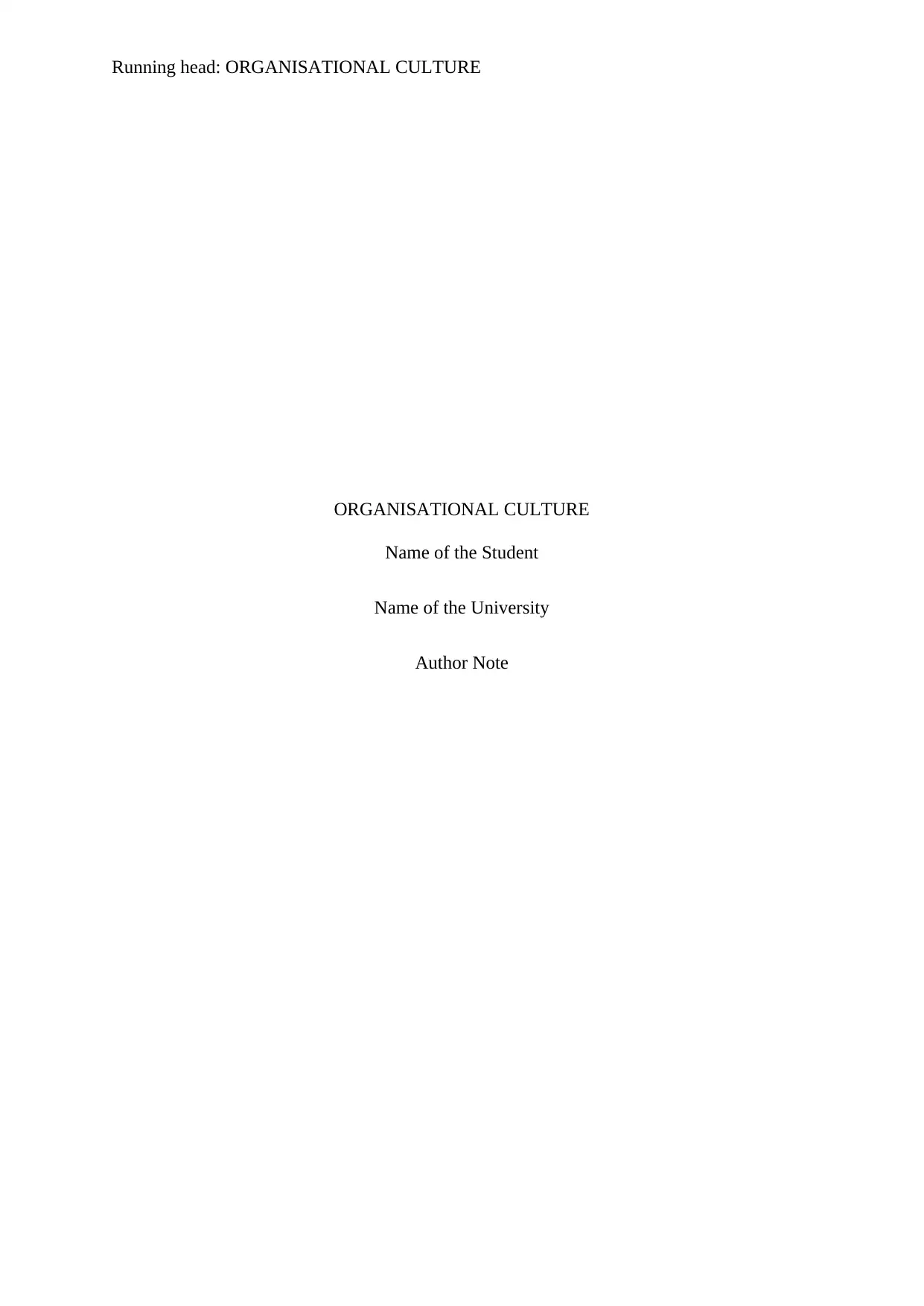
Running head: ORGANISATIONAL CULTURE
ORGANISATIONAL CULTURE
Name of the Student
Name of the University
Author Note
ORGANISATIONAL CULTURE
Name of the Student
Name of the University
Author Note
Paraphrase This Document
Need a fresh take? Get an instant paraphrase of this document with our AI Paraphraser
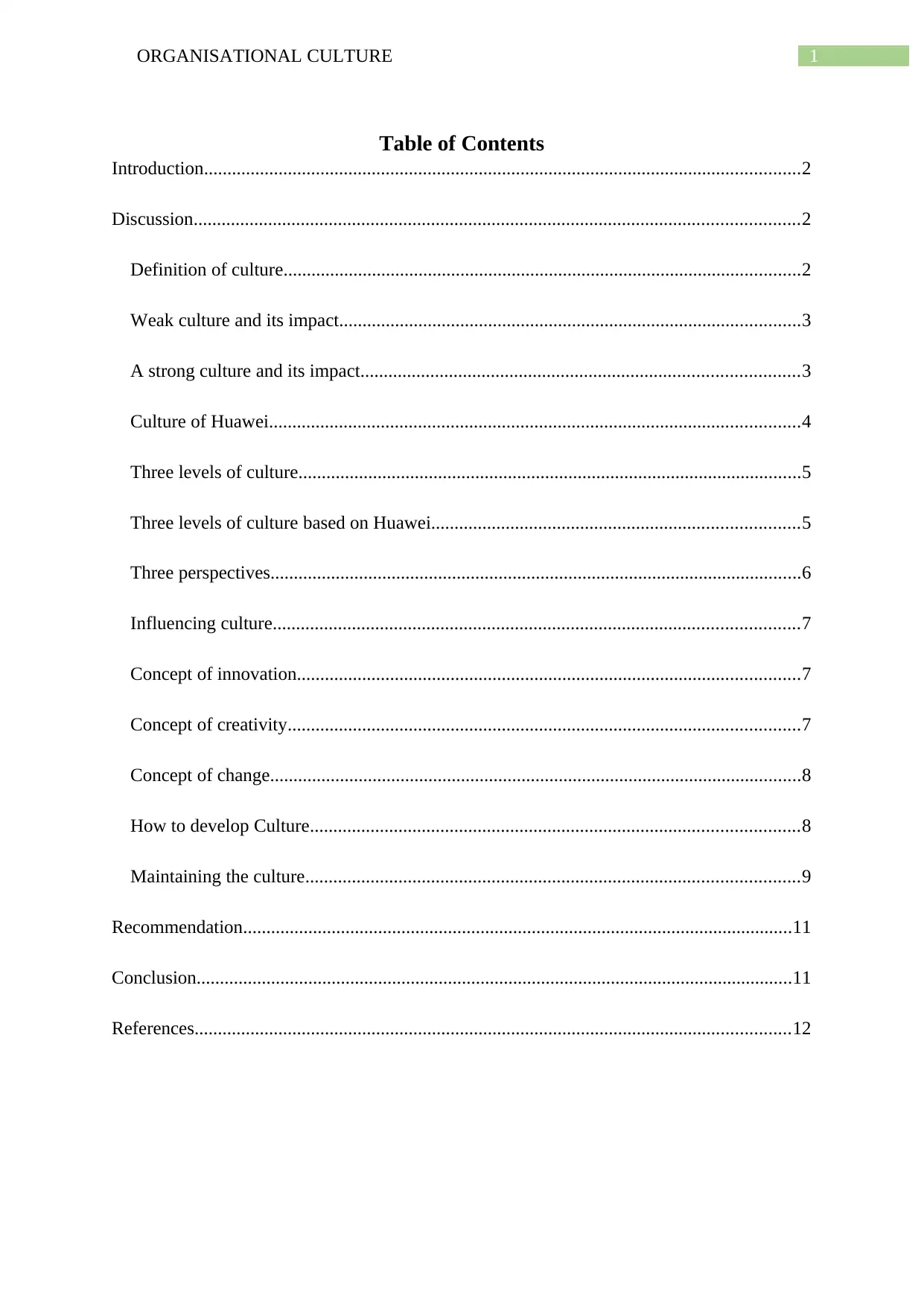
1ORGANISATIONAL CULTURE
Table of Contents
Introduction................................................................................................................................2
Discussion..................................................................................................................................2
Definition of culture...............................................................................................................2
Weak culture and its impact...................................................................................................3
A strong culture and its impact..............................................................................................3
Culture of Huawei..................................................................................................................4
Three levels of culture............................................................................................................5
Three levels of culture based on Huawei...............................................................................5
Three perspectives..................................................................................................................6
Influencing culture.................................................................................................................7
Concept of innovation............................................................................................................7
Concept of creativity..............................................................................................................7
Concept of change..................................................................................................................8
How to develop Culture.........................................................................................................8
Maintaining the culture..........................................................................................................9
Recommendation......................................................................................................................11
Conclusion................................................................................................................................11
References................................................................................................................................12
Table of Contents
Introduction................................................................................................................................2
Discussion..................................................................................................................................2
Definition of culture...............................................................................................................2
Weak culture and its impact...................................................................................................3
A strong culture and its impact..............................................................................................3
Culture of Huawei..................................................................................................................4
Three levels of culture............................................................................................................5
Three levels of culture based on Huawei...............................................................................5
Three perspectives..................................................................................................................6
Influencing culture.................................................................................................................7
Concept of innovation............................................................................................................7
Concept of creativity..............................................................................................................7
Concept of change..................................................................................................................8
How to develop Culture.........................................................................................................8
Maintaining the culture..........................................................................................................9
Recommendation......................................................................................................................11
Conclusion................................................................................................................................11
References................................................................................................................................12
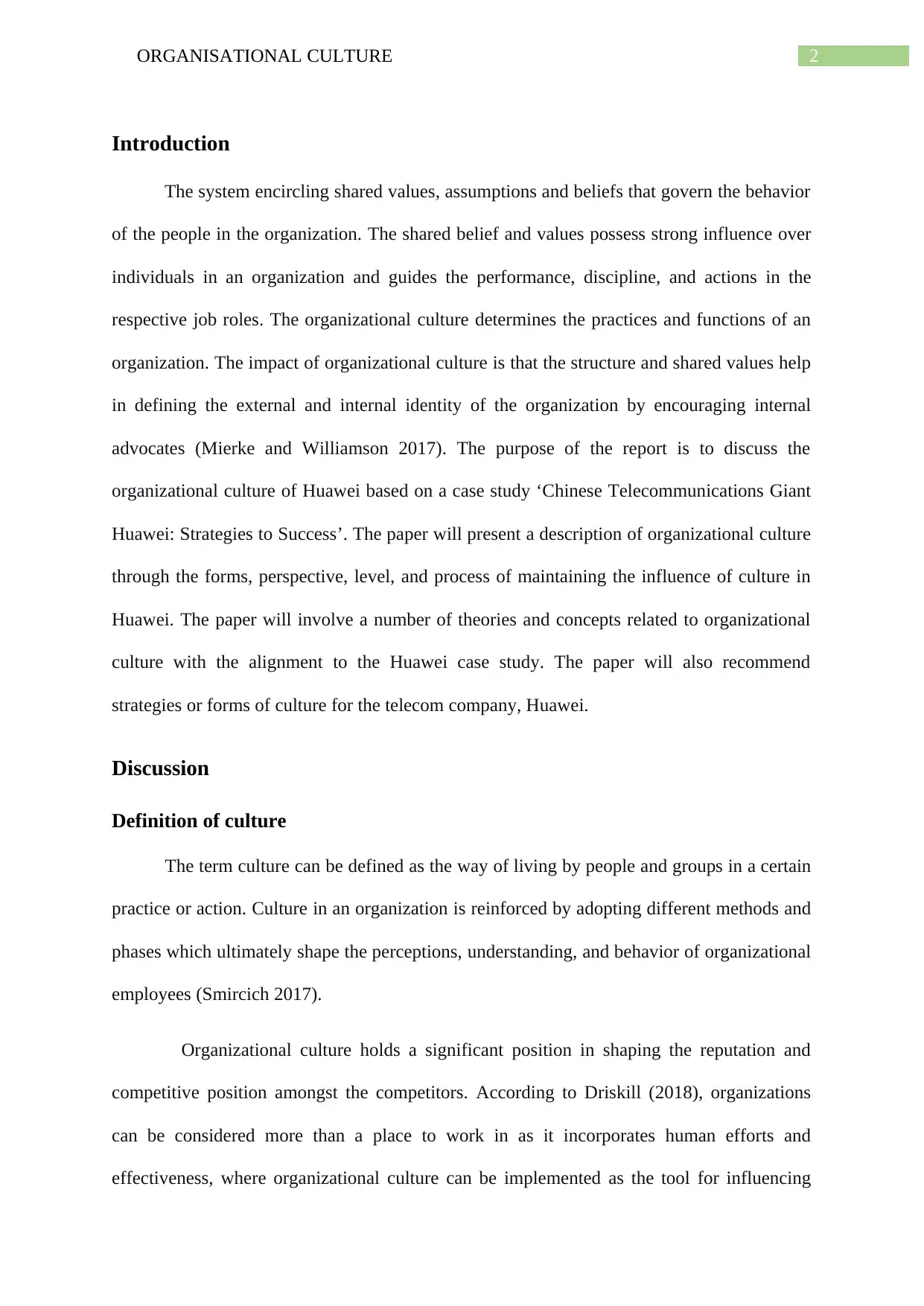
2ORGANISATIONAL CULTURE
Introduction
The system encircling shared values, assumptions and beliefs that govern the behavior
of the people in the organization. The shared belief and values possess strong influence over
individuals in an organization and guides the performance, discipline, and actions in the
respective job roles. The organizational culture determines the practices and functions of an
organization. The impact of organizational culture is that the structure and shared values help
in defining the external and internal identity of the organization by encouraging internal
advocates (Mierke and Williamson 2017). The purpose of the report is to discuss the
organizational culture of Huawei based on a case study ‘Chinese Telecommunications Giant
Huawei: Strategies to Success’. The paper will present a description of organizational culture
through the forms, perspective, level, and process of maintaining the influence of culture in
Huawei. The paper will involve a number of theories and concepts related to organizational
culture with the alignment to the Huawei case study. The paper will also recommend
strategies or forms of culture for the telecom company, Huawei.
Discussion
Definition of culture
The term culture can be defined as the way of living by people and groups in a certain
practice or action. Culture in an organization is reinforced by adopting different methods and
phases which ultimately shape the perceptions, understanding, and behavior of organizational
employees (Smircich 2017).
Organizational culture holds a significant position in shaping the reputation and
competitive position amongst the competitors. According to Driskill (2018), organizations
can be considered more than a place to work in as it incorporates human efforts and
effectiveness, where organizational culture can be implemented as the tool for influencing
Introduction
The system encircling shared values, assumptions and beliefs that govern the behavior
of the people in the organization. The shared belief and values possess strong influence over
individuals in an organization and guides the performance, discipline, and actions in the
respective job roles. The organizational culture determines the practices and functions of an
organization. The impact of organizational culture is that the structure and shared values help
in defining the external and internal identity of the organization by encouraging internal
advocates (Mierke and Williamson 2017). The purpose of the report is to discuss the
organizational culture of Huawei based on a case study ‘Chinese Telecommunications Giant
Huawei: Strategies to Success’. The paper will present a description of organizational culture
through the forms, perspective, level, and process of maintaining the influence of culture in
Huawei. The paper will involve a number of theories and concepts related to organizational
culture with the alignment to the Huawei case study. The paper will also recommend
strategies or forms of culture for the telecom company, Huawei.
Discussion
Definition of culture
The term culture can be defined as the way of living by people and groups in a certain
practice or action. Culture in an organization is reinforced by adopting different methods and
phases which ultimately shape the perceptions, understanding, and behavior of organizational
employees (Smircich 2017).
Organizational culture holds a significant position in shaping the reputation and
competitive position amongst the competitors. According to Driskill (2018), organizations
can be considered more than a place to work in as it incorporates human efforts and
effectiveness, where organizational culture can be implemented as the tool for influencing
⊘ This is a preview!⊘
Do you want full access?
Subscribe today to unlock all pages.

Trusted by 1+ million students worldwide
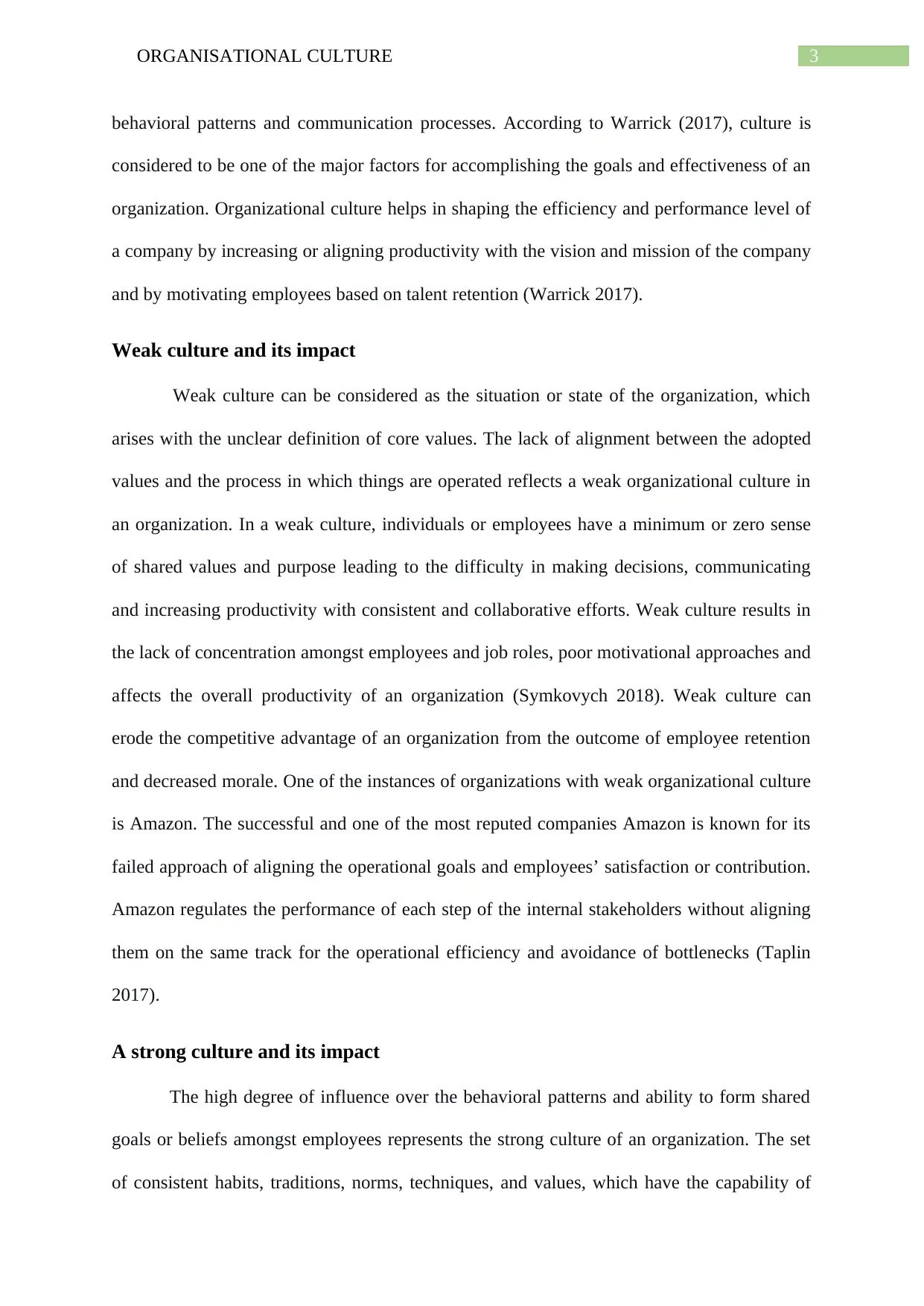
3ORGANISATIONAL CULTURE
behavioral patterns and communication processes. According to Warrick (2017), culture is
considered to be one of the major factors for accomplishing the goals and effectiveness of an
organization. Organizational culture helps in shaping the efficiency and performance level of
a company by increasing or aligning productivity with the vision and mission of the company
and by motivating employees based on talent retention (Warrick 2017).
Weak culture and its impact
Weak culture can be considered as the situation or state of the organization, which
arises with the unclear definition of core values. The lack of alignment between the adopted
values and the process in which things are operated reflects a weak organizational culture in
an organization. In a weak culture, individuals or employees have a minimum or zero sense
of shared values and purpose leading to the difficulty in making decisions, communicating
and increasing productivity with consistent and collaborative efforts. Weak culture results in
the lack of concentration amongst employees and job roles, poor motivational approaches and
affects the overall productivity of an organization (Symkovych 2018). Weak culture can
erode the competitive advantage of an organization from the outcome of employee retention
and decreased morale. One of the instances of organizations with weak organizational culture
is Amazon. The successful and one of the most reputed companies Amazon is known for its
failed approach of aligning the operational goals and employees’ satisfaction or contribution.
Amazon regulates the performance of each step of the internal stakeholders without aligning
them on the same track for the operational efficiency and avoidance of bottlenecks (Taplin
2017).
A strong culture and its impact
The high degree of influence over the behavioral patterns and ability to form shared
goals or beliefs amongst employees represents the strong culture of an organization. The set
of consistent habits, traditions, norms, techniques, and values, which have the capability of
behavioral patterns and communication processes. According to Warrick (2017), culture is
considered to be one of the major factors for accomplishing the goals and effectiveness of an
organization. Organizational culture helps in shaping the efficiency and performance level of
a company by increasing or aligning productivity with the vision and mission of the company
and by motivating employees based on talent retention (Warrick 2017).
Weak culture and its impact
Weak culture can be considered as the situation or state of the organization, which
arises with the unclear definition of core values. The lack of alignment between the adopted
values and the process in which things are operated reflects a weak organizational culture in
an organization. In a weak culture, individuals or employees have a minimum or zero sense
of shared values and purpose leading to the difficulty in making decisions, communicating
and increasing productivity with consistent and collaborative efforts. Weak culture results in
the lack of concentration amongst employees and job roles, poor motivational approaches and
affects the overall productivity of an organization (Symkovych 2018). Weak culture can
erode the competitive advantage of an organization from the outcome of employee retention
and decreased morale. One of the instances of organizations with weak organizational culture
is Amazon. The successful and one of the most reputed companies Amazon is known for its
failed approach of aligning the operational goals and employees’ satisfaction or contribution.
Amazon regulates the performance of each step of the internal stakeholders without aligning
them on the same track for the operational efficiency and avoidance of bottlenecks (Taplin
2017).
A strong culture and its impact
The high degree of influence over the behavioral patterns and ability to form shared
goals or beliefs amongst employees represents the strong culture of an organization. The set
of consistent habits, traditions, norms, techniques, and values, which have the capability of
Paraphrase This Document
Need a fresh take? Get an instant paraphrase of this document with our AI Paraphraser
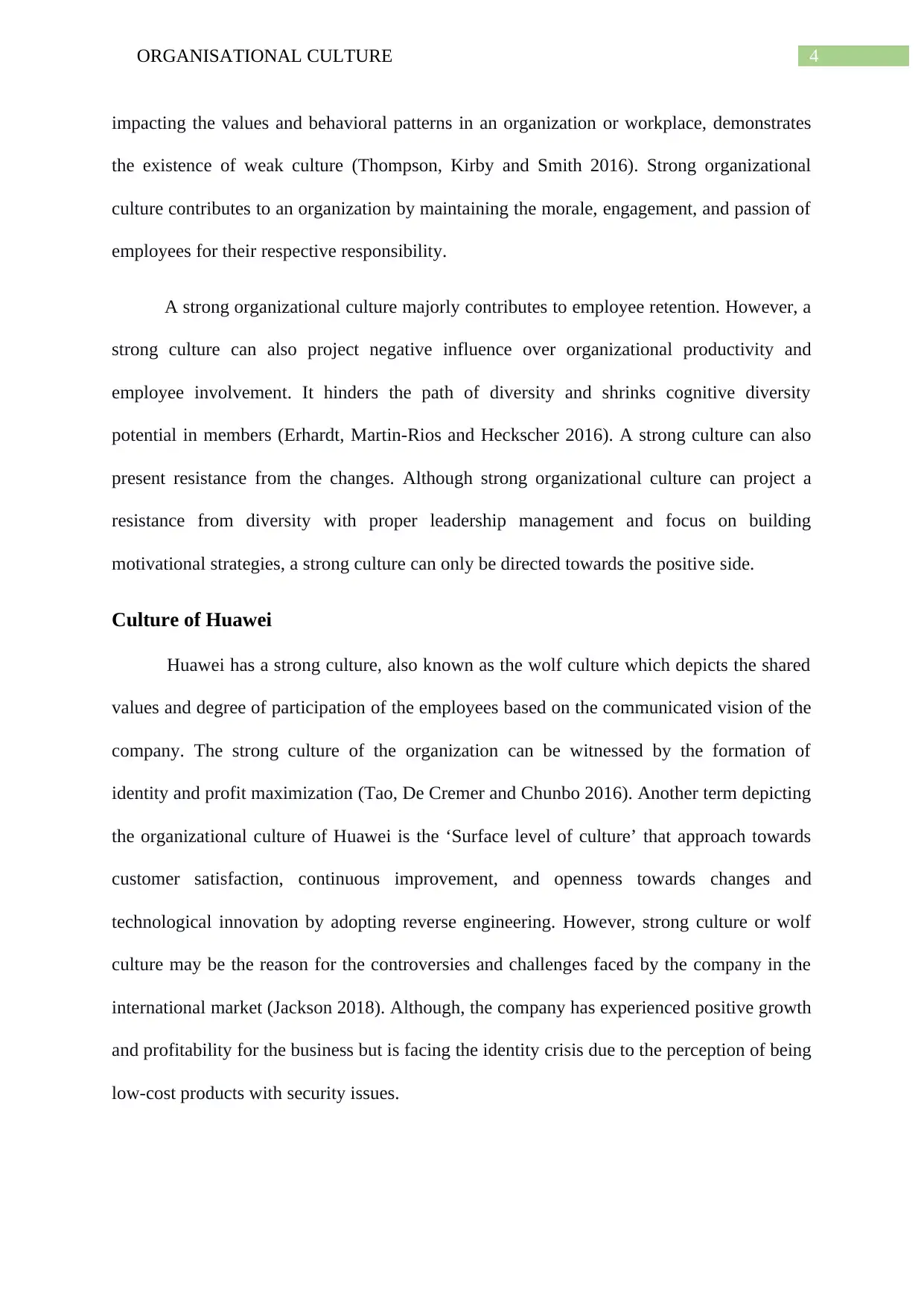
4ORGANISATIONAL CULTURE
impacting the values and behavioral patterns in an organization or workplace, demonstrates
the existence of weak culture (Thompson, Kirby and Smith 2016). Strong organizational
culture contributes to an organization by maintaining the morale, engagement, and passion of
employees for their respective responsibility.
A strong organizational culture majorly contributes to employee retention. However, a
strong culture can also project negative influence over organizational productivity and
employee involvement. It hinders the path of diversity and shrinks cognitive diversity
potential in members (Erhardt, Martin-Rios and Heckscher 2016). A strong culture can also
present resistance from the changes. Although strong organizational culture can project a
resistance from diversity with proper leadership management and focus on building
motivational strategies, a strong culture can only be directed towards the positive side.
Culture of Huawei
Huawei has a strong culture, also known as the wolf culture which depicts the shared
values and degree of participation of the employees based on the communicated vision of the
company. The strong culture of the organization can be witnessed by the formation of
identity and profit maximization (Tao, De Cremer and Chunbo 2016). Another term depicting
the organizational culture of Huawei is the ‘Surface level of culture’ that approach towards
customer satisfaction, continuous improvement, and openness towards changes and
technological innovation by adopting reverse engineering. However, strong culture or wolf
culture may be the reason for the controversies and challenges faced by the company in the
international market (Jackson 2018). Although, the company has experienced positive growth
and profitability for the business but is facing the identity crisis due to the perception of being
low-cost products with security issues.
impacting the values and behavioral patterns in an organization or workplace, demonstrates
the existence of weak culture (Thompson, Kirby and Smith 2016). Strong organizational
culture contributes to an organization by maintaining the morale, engagement, and passion of
employees for their respective responsibility.
A strong organizational culture majorly contributes to employee retention. However, a
strong culture can also project negative influence over organizational productivity and
employee involvement. It hinders the path of diversity and shrinks cognitive diversity
potential in members (Erhardt, Martin-Rios and Heckscher 2016). A strong culture can also
present resistance from the changes. Although strong organizational culture can project a
resistance from diversity with proper leadership management and focus on building
motivational strategies, a strong culture can only be directed towards the positive side.
Culture of Huawei
Huawei has a strong culture, also known as the wolf culture which depicts the shared
values and degree of participation of the employees based on the communicated vision of the
company. The strong culture of the organization can be witnessed by the formation of
identity and profit maximization (Tao, De Cremer and Chunbo 2016). Another term depicting
the organizational culture of Huawei is the ‘Surface level of culture’ that approach towards
customer satisfaction, continuous improvement, and openness towards changes and
technological innovation by adopting reverse engineering. However, strong culture or wolf
culture may be the reason for the controversies and challenges faced by the company in the
international market (Jackson 2018). Although, the company has experienced positive growth
and profitability for the business but is facing the identity crisis due to the perception of being
low-cost products with security issues.
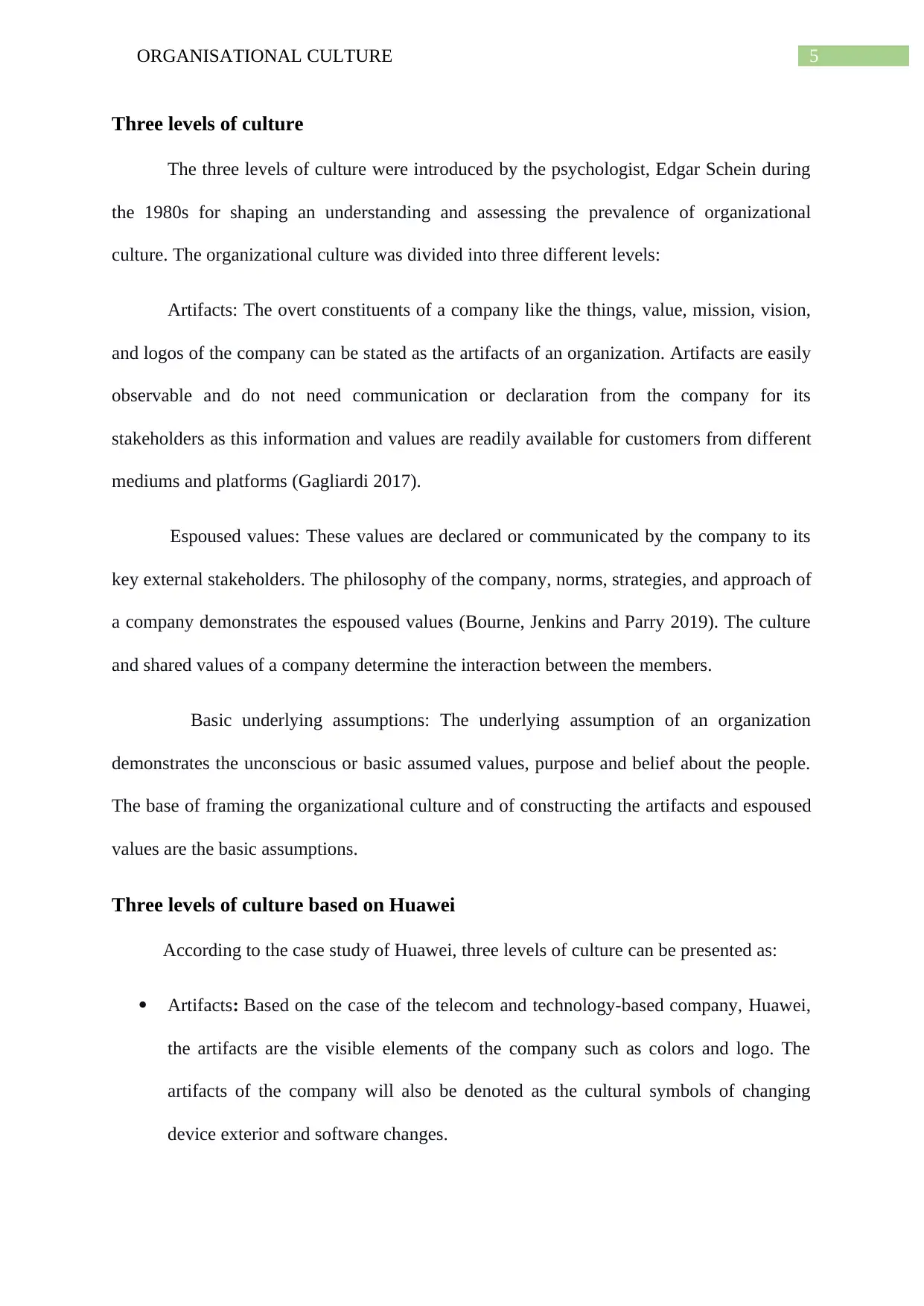
5ORGANISATIONAL CULTURE
Three levels of culture
The three levels of culture were introduced by the psychologist, Edgar Schein during
the 1980s for shaping an understanding and assessing the prevalence of organizational
culture. The organizational culture was divided into three different levels:
Artifacts: The overt constituents of a company like the things, value, mission, vision,
and logos of the company can be stated as the artifacts of an organization. Artifacts are easily
observable and do not need communication or declaration from the company for its
stakeholders as this information and values are readily available for customers from different
mediums and platforms (Gagliardi 2017).
Espoused values: These values are declared or communicated by the company to its
key external stakeholders. The philosophy of the company, norms, strategies, and approach of
a company demonstrates the espoused values (Bourne, Jenkins and Parry 2019). The culture
and shared values of a company determine the interaction between the members.
Basic underlying assumptions: The underlying assumption of an organization
demonstrates the unconscious or basic assumed values, purpose and belief about the people.
The base of framing the organizational culture and of constructing the artifacts and espoused
values are the basic assumptions.
Three levels of culture based on Huawei
According to the case study of Huawei, three levels of culture can be presented as:
Artifacts: Based on the case of the telecom and technology-based company, Huawei,
the artifacts are the visible elements of the company such as colors and logo. The
artifacts of the company will also be denoted as the cultural symbols of changing
device exterior and software changes.
Three levels of culture
The three levels of culture were introduced by the psychologist, Edgar Schein during
the 1980s for shaping an understanding and assessing the prevalence of organizational
culture. The organizational culture was divided into three different levels:
Artifacts: The overt constituents of a company like the things, value, mission, vision,
and logos of the company can be stated as the artifacts of an organization. Artifacts are easily
observable and do not need communication or declaration from the company for its
stakeholders as this information and values are readily available for customers from different
mediums and platforms (Gagliardi 2017).
Espoused values: These values are declared or communicated by the company to its
key external stakeholders. The philosophy of the company, norms, strategies, and approach of
a company demonstrates the espoused values (Bourne, Jenkins and Parry 2019). The culture
and shared values of a company determine the interaction between the members.
Basic underlying assumptions: The underlying assumption of an organization
demonstrates the unconscious or basic assumed values, purpose and belief about the people.
The base of framing the organizational culture and of constructing the artifacts and espoused
values are the basic assumptions.
Three levels of culture based on Huawei
According to the case study of Huawei, three levels of culture can be presented as:
Artifacts: Based on the case of the telecom and technology-based company, Huawei,
the artifacts are the visible elements of the company such as colors and logo. The
artifacts of the company will also be denoted as the cultural symbols of changing
device exterior and software changes.
⊘ This is a preview!⊘
Do you want full access?
Subscribe today to unlock all pages.

Trusted by 1+ million students worldwide
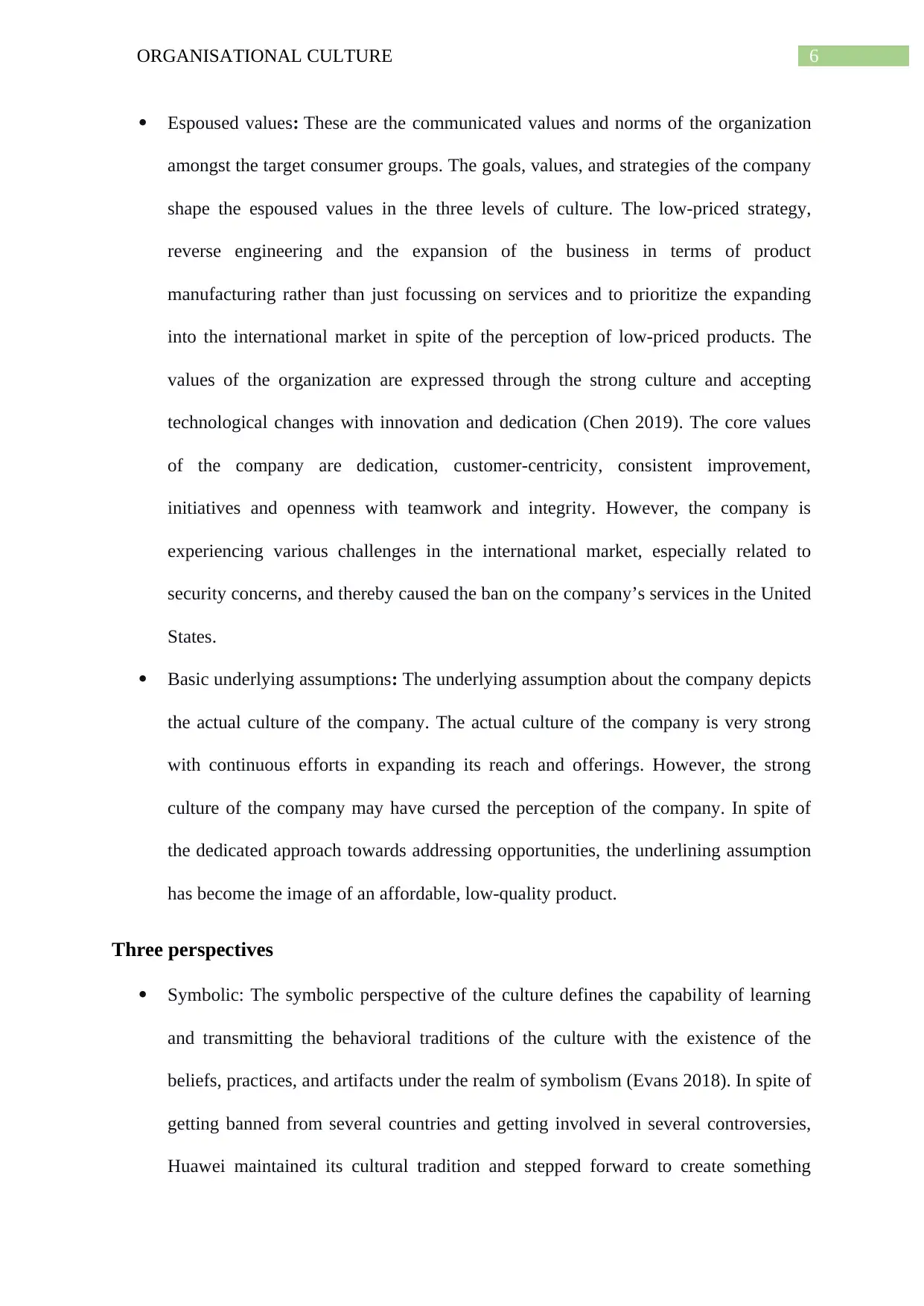
6ORGANISATIONAL CULTURE
Espoused values: These are the communicated values and norms of the organization
amongst the target consumer groups. The goals, values, and strategies of the company
shape the espoused values in the three levels of culture. The low-priced strategy,
reverse engineering and the expansion of the business in terms of product
manufacturing rather than just focussing on services and to prioritize the expanding
into the international market in spite of the perception of low-priced products. The
values of the organization are expressed through the strong culture and accepting
technological changes with innovation and dedication (Chen 2019). The core values
of the company are dedication, customer-centricity, consistent improvement,
initiatives and openness with teamwork and integrity. However, the company is
experiencing various challenges in the international market, especially related to
security concerns, and thereby caused the ban on the company’s services in the United
States.
Basic underlying assumptions: The underlying assumption about the company depicts
the actual culture of the company. The actual culture of the company is very strong
with continuous efforts in expanding its reach and offerings. However, the strong
culture of the company may have cursed the perception of the company. In spite of
the dedicated approach towards addressing opportunities, the underlining assumption
has become the image of an affordable, low-quality product.
Three perspectives
Symbolic: The symbolic perspective of the culture defines the capability of learning
and transmitting the behavioral traditions of the culture with the existence of the
beliefs, practices, and artifacts under the realm of symbolism (Evans 2018). In spite of
getting banned from several countries and getting involved in several controversies,
Huawei maintained its cultural tradition and stepped forward to create something
Espoused values: These are the communicated values and norms of the organization
amongst the target consumer groups. The goals, values, and strategies of the company
shape the espoused values in the three levels of culture. The low-priced strategy,
reverse engineering and the expansion of the business in terms of product
manufacturing rather than just focussing on services and to prioritize the expanding
into the international market in spite of the perception of low-priced products. The
values of the organization are expressed through the strong culture and accepting
technological changes with innovation and dedication (Chen 2019). The core values
of the company are dedication, customer-centricity, consistent improvement,
initiatives and openness with teamwork and integrity. However, the company is
experiencing various challenges in the international market, especially related to
security concerns, and thereby caused the ban on the company’s services in the United
States.
Basic underlying assumptions: The underlying assumption about the company depicts
the actual culture of the company. The actual culture of the company is very strong
with continuous efforts in expanding its reach and offerings. However, the strong
culture of the company may have cursed the perception of the company. In spite of
the dedicated approach towards addressing opportunities, the underlining assumption
has become the image of an affordable, low-quality product.
Three perspectives
Symbolic: The symbolic perspective of the culture defines the capability of learning
and transmitting the behavioral traditions of the culture with the existence of the
beliefs, practices, and artifacts under the realm of symbolism (Evans 2018). In spite of
getting banned from several countries and getting involved in several controversies,
Huawei maintained its cultural tradition and stepped forward to create something
Paraphrase This Document
Need a fresh take? Get an instant paraphrase of this document with our AI Paraphraser
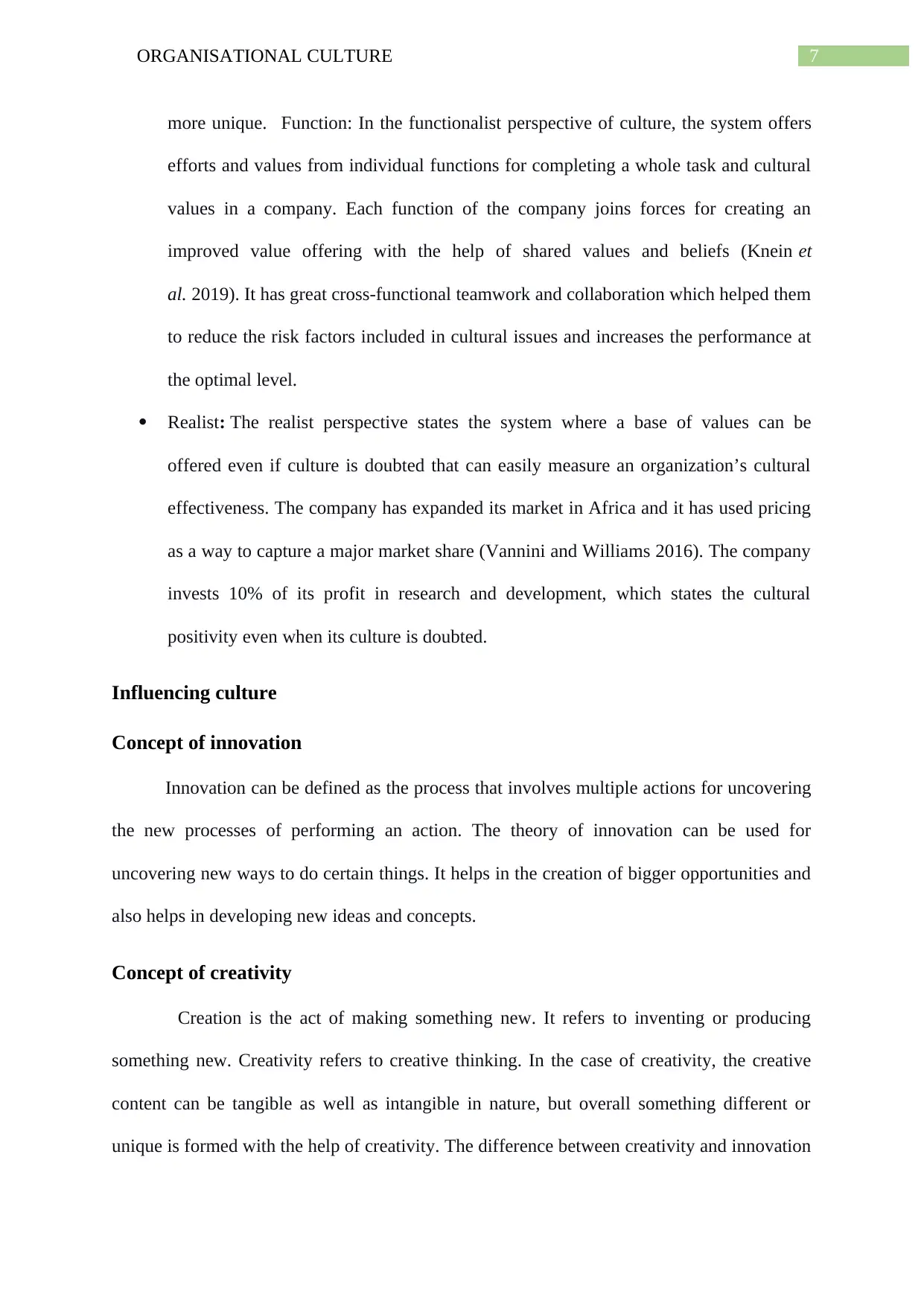
7ORGANISATIONAL CULTURE
more unique. Function: In the functionalist perspective of culture, the system offers
efforts and values from individual functions for completing a whole task and cultural
values in a company. Each function of the company joins forces for creating an
improved value offering with the help of shared values and beliefs (Knein et
al. 2019). It has great cross-functional teamwork and collaboration which helped them
to reduce the risk factors included in cultural issues and increases the performance at
the optimal level.
Realist: The realist perspective states the system where a base of values can be
offered even if culture is doubted that can easily measure an organization’s cultural
effectiveness. The company has expanded its market in Africa and it has used pricing
as a way to capture a major market share (Vannini and Williams 2016). The company
invests 10% of its profit in research and development, which states the cultural
positivity even when its culture is doubted.
Influencing culture
Concept of innovation
Innovation can be defined as the process that involves multiple actions for uncovering
the new processes of performing an action. The theory of innovation can be used for
uncovering new ways to do certain things. It helps in the creation of bigger opportunities and
also helps in developing new ideas and concepts.
Concept of creativity
Creation is the act of making something new. It refers to inventing or producing
something new. Creativity refers to creative thinking. In the case of creativity, the creative
content can be tangible as well as intangible in nature, but overall something different or
unique is formed with the help of creativity. The difference between creativity and innovation
more unique. Function: In the functionalist perspective of culture, the system offers
efforts and values from individual functions for completing a whole task and cultural
values in a company. Each function of the company joins forces for creating an
improved value offering with the help of shared values and beliefs (Knein et
al. 2019). It has great cross-functional teamwork and collaboration which helped them
to reduce the risk factors included in cultural issues and increases the performance at
the optimal level.
Realist: The realist perspective states the system where a base of values can be
offered even if culture is doubted that can easily measure an organization’s cultural
effectiveness. The company has expanded its market in Africa and it has used pricing
as a way to capture a major market share (Vannini and Williams 2016). The company
invests 10% of its profit in research and development, which states the cultural
positivity even when its culture is doubted.
Influencing culture
Concept of innovation
Innovation can be defined as the process that involves multiple actions for uncovering
the new processes of performing an action. The theory of innovation can be used for
uncovering new ways to do certain things. It helps in the creation of bigger opportunities and
also helps in developing new ideas and concepts.
Concept of creativity
Creation is the act of making something new. It refers to inventing or producing
something new. Creativity refers to creative thinking. In the case of creativity, the creative
content can be tangible as well as intangible in nature, but overall something different or
unique is formed with the help of creativity. The difference between creativity and innovation
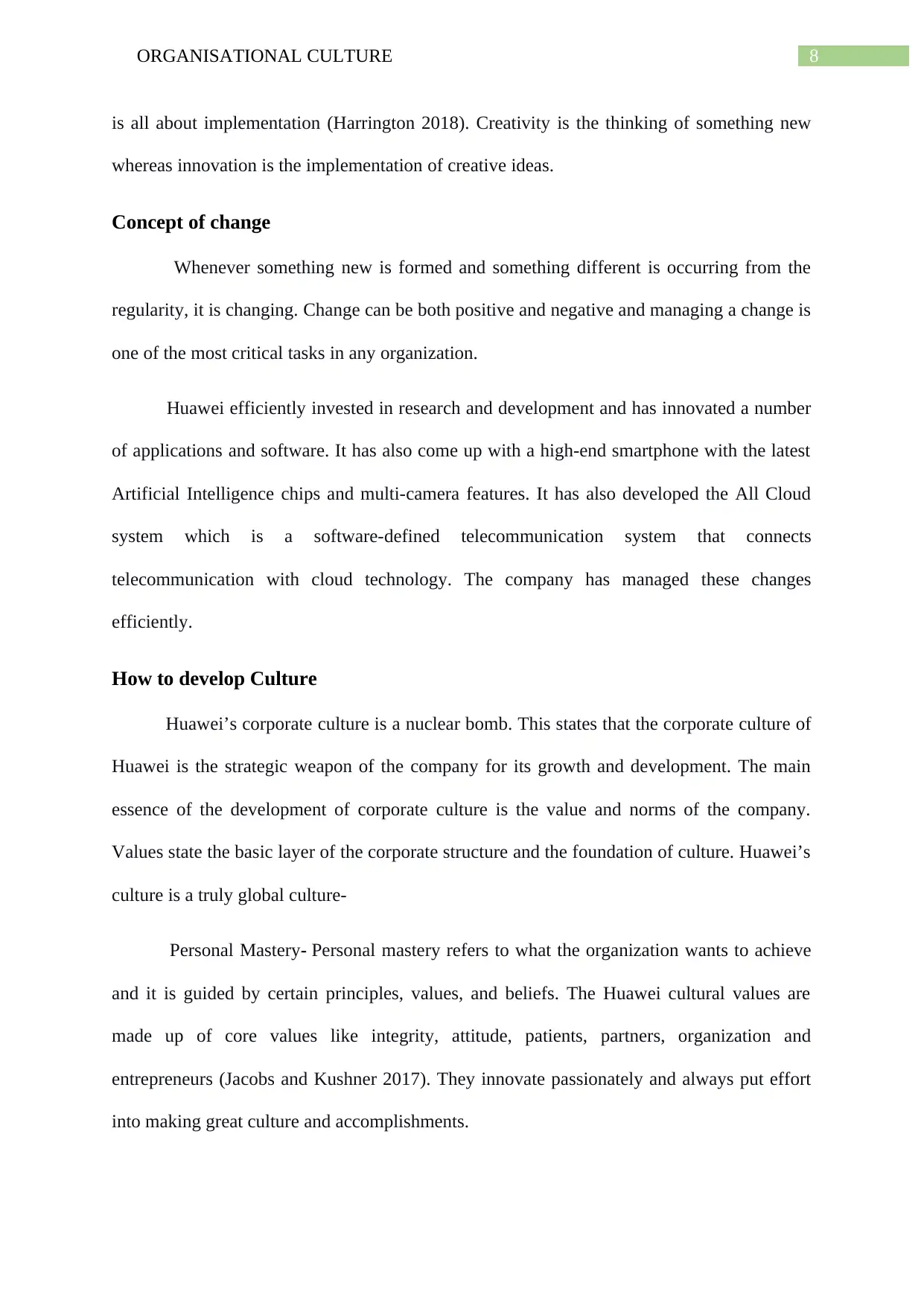
8ORGANISATIONAL CULTURE
is all about implementation (Harrington 2018). Creativity is the thinking of something new
whereas innovation is the implementation of creative ideas.
Concept of change
Whenever something new is formed and something different is occurring from the
regularity, it is changing. Change can be both positive and negative and managing a change is
one of the most critical tasks in any organization.
Huawei efficiently invested in research and development and has innovated a number
of applications and software. It has also come up with a high-end smartphone with the latest
Artificial Intelligence chips and multi-camera features. It has also developed the All Cloud
system which is a software-defined telecommunication system that connects
telecommunication with cloud technology. The company has managed these changes
efficiently.
How to develop Culture
Huawei’s corporate culture is a nuclear bomb. This states that the corporate culture of
Huawei is the strategic weapon of the company for its growth and development. The main
essence of the development of corporate culture is the value and norms of the company.
Values state the basic layer of the corporate structure and the foundation of culture. Huawei’s
culture is a truly global culture-
Personal Mastery- Personal mastery refers to what the organization wants to achieve
and it is guided by certain principles, values, and beliefs. The Huawei cultural values are
made up of core values like integrity, attitude, patients, partners, organization and
entrepreneurs (Jacobs and Kushner 2017). They innovate passionately and always put effort
into making great culture and accomplishments.
is all about implementation (Harrington 2018). Creativity is the thinking of something new
whereas innovation is the implementation of creative ideas.
Concept of change
Whenever something new is formed and something different is occurring from the
regularity, it is changing. Change can be both positive and negative and managing a change is
one of the most critical tasks in any organization.
Huawei efficiently invested in research and development and has innovated a number
of applications and software. It has also come up with a high-end smartphone with the latest
Artificial Intelligence chips and multi-camera features. It has also developed the All Cloud
system which is a software-defined telecommunication system that connects
telecommunication with cloud technology. The company has managed these changes
efficiently.
How to develop Culture
Huawei’s corporate culture is a nuclear bomb. This states that the corporate culture of
Huawei is the strategic weapon of the company for its growth and development. The main
essence of the development of corporate culture is the value and norms of the company.
Values state the basic layer of the corporate structure and the foundation of culture. Huawei’s
culture is a truly global culture-
Personal Mastery- Personal mastery refers to what the organization wants to achieve
and it is guided by certain principles, values, and beliefs. The Huawei cultural values are
made up of core values like integrity, attitude, patients, partners, organization and
entrepreneurs (Jacobs and Kushner 2017). They innovate passionately and always put effort
into making great culture and accomplishments.
⊘ This is a preview!⊘
Do you want full access?
Subscribe today to unlock all pages.

Trusted by 1+ million students worldwide
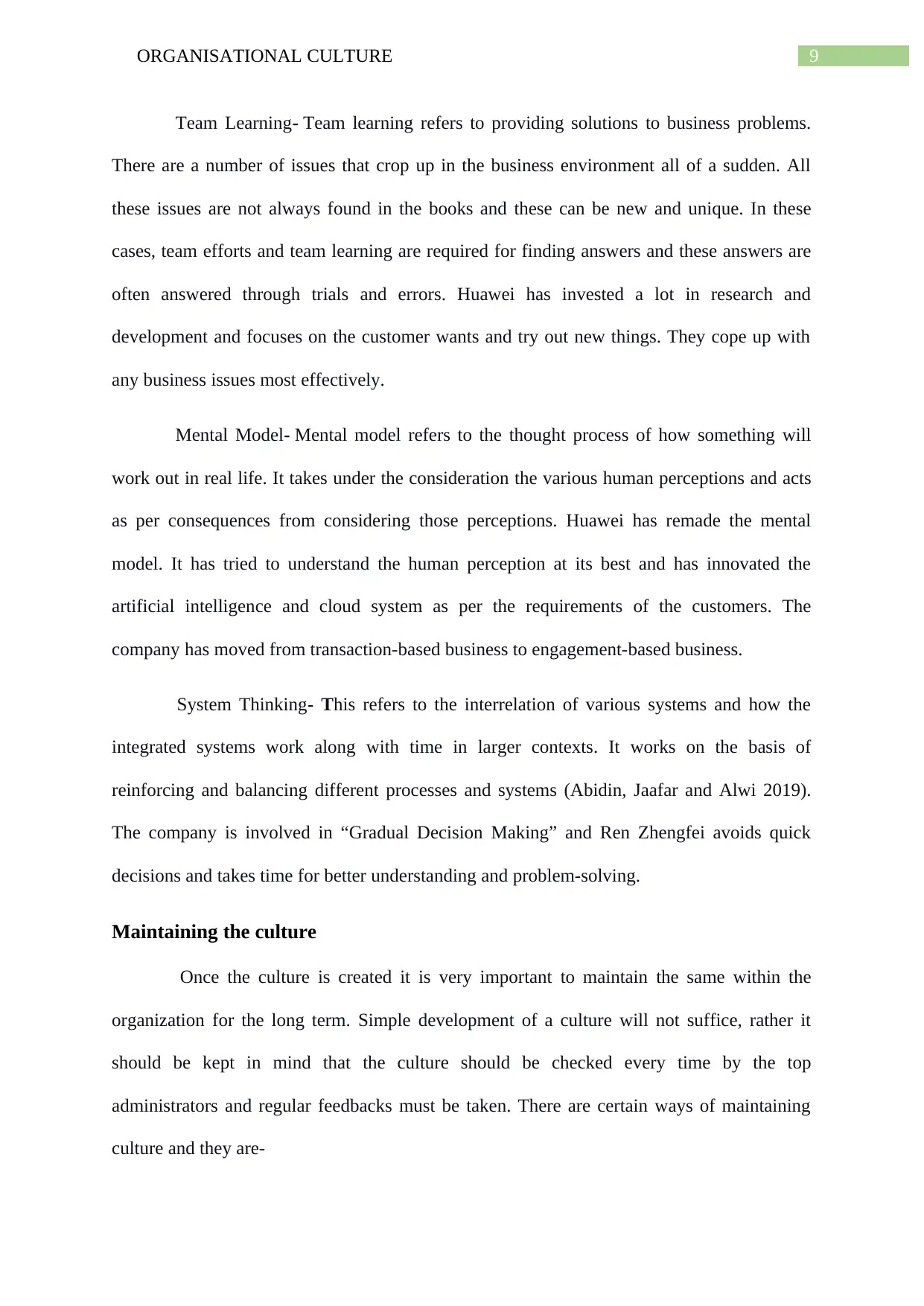
9ORGANISATIONAL CULTURE
Team Learning- Team learning refers to providing solutions to business problems.
There are a number of issues that crop up in the business environment all of a sudden. All
these issues are not always found in the books and these can be new and unique. In these
cases, team efforts and team learning are required for finding answers and these answers are
often answered through trials and errors. Huawei has invested a lot in research and
development and focuses on the customer wants and try out new things. They cope up with
any business issues most effectively.
Mental Model- Mental model refers to the thought process of how something will
work out in real life. It takes under the consideration the various human perceptions and acts
as per consequences from considering those perceptions. Huawei has remade the mental
model. It has tried to understand the human perception at its best and has innovated the
artificial intelligence and cloud system as per the requirements of the customers. The
company has moved from transaction-based business to engagement-based business.
System Thinking- This refers to the interrelation of various systems and how the
integrated systems work along with time in larger contexts. It works on the basis of
reinforcing and balancing different processes and systems (Abidin, Jaafar and Alwi 2019).
The company is involved in “Gradual Decision Making” and Ren Zhengfei avoids quick
decisions and takes time for better understanding and problem-solving.
Maintaining the culture
Once the culture is created it is very important to maintain the same within the
organization for the long term. Simple development of a culture will not suffice, rather it
should be kept in mind that the culture should be checked every time by the top
administrators and regular feedbacks must be taken. There are certain ways of maintaining
culture and they are-
Team Learning- Team learning refers to providing solutions to business problems.
There are a number of issues that crop up in the business environment all of a sudden. All
these issues are not always found in the books and these can be new and unique. In these
cases, team efforts and team learning are required for finding answers and these answers are
often answered through trials and errors. Huawei has invested a lot in research and
development and focuses on the customer wants and try out new things. They cope up with
any business issues most effectively.
Mental Model- Mental model refers to the thought process of how something will
work out in real life. It takes under the consideration the various human perceptions and acts
as per consequences from considering those perceptions. Huawei has remade the mental
model. It has tried to understand the human perception at its best and has innovated the
artificial intelligence and cloud system as per the requirements of the customers. The
company has moved from transaction-based business to engagement-based business.
System Thinking- This refers to the interrelation of various systems and how the
integrated systems work along with time in larger contexts. It works on the basis of
reinforcing and balancing different processes and systems (Abidin, Jaafar and Alwi 2019).
The company is involved in “Gradual Decision Making” and Ren Zhengfei avoids quick
decisions and takes time for better understanding and problem-solving.
Maintaining the culture
Once the culture is created it is very important to maintain the same within the
organization for the long term. Simple development of a culture will not suffice, rather it
should be kept in mind that the culture should be checked every time by the top
administrators and regular feedbacks must be taken. There are certain ways of maintaining
culture and they are-
Paraphrase This Document
Need a fresh take? Get an instant paraphrase of this document with our AI Paraphraser
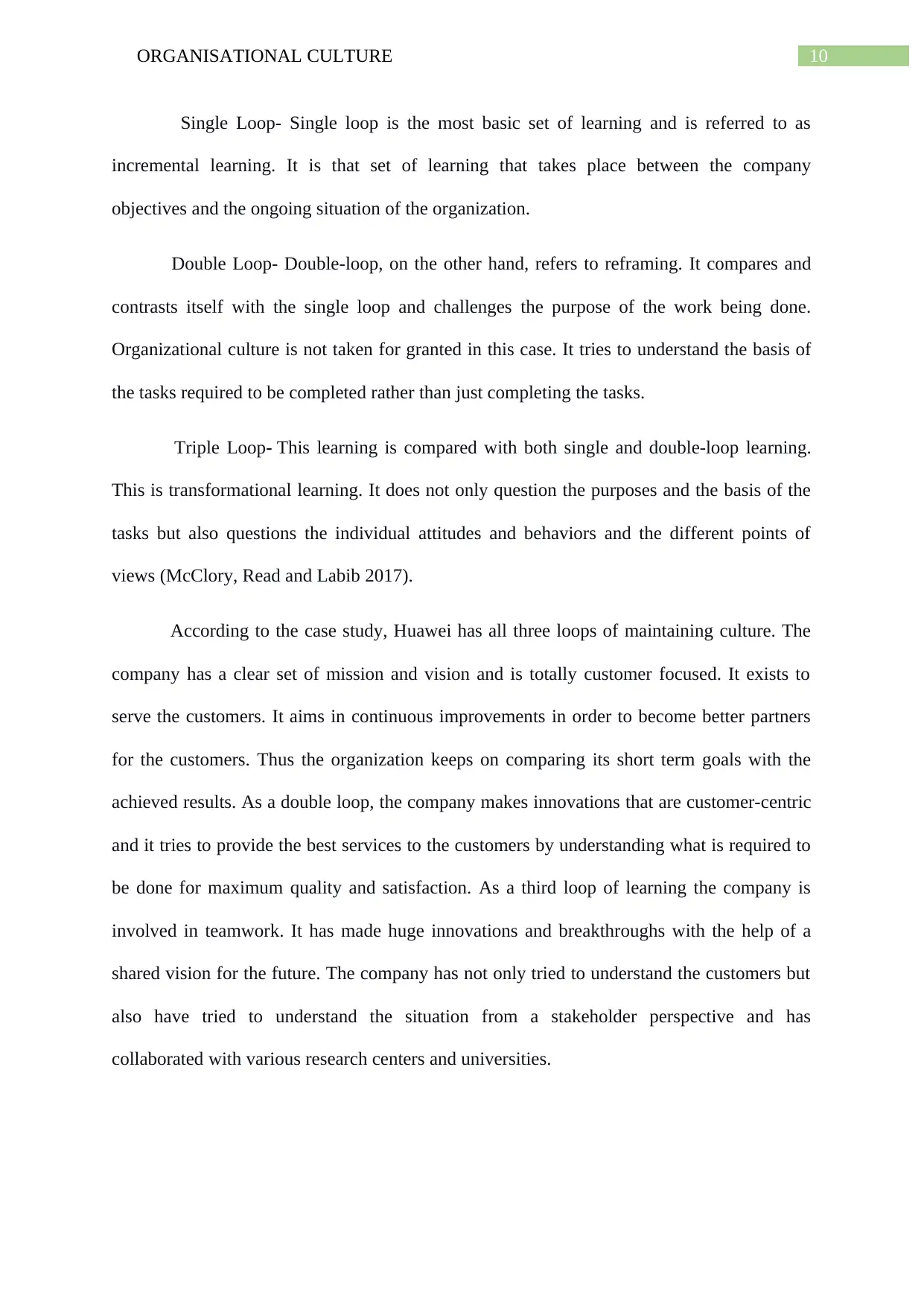
10ORGANISATIONAL CULTURE
Single Loop- Single loop is the most basic set of learning and is referred to as
incremental learning. It is that set of learning that takes place between the company
objectives and the ongoing situation of the organization.
Double Loop- Double-loop, on the other hand, refers to reframing. It compares and
contrasts itself with the single loop and challenges the purpose of the work being done.
Organizational culture is not taken for granted in this case. It tries to understand the basis of
the tasks required to be completed rather than just completing the tasks.
Triple Loop- This learning is compared with both single and double-loop learning.
This is transformational learning. It does not only question the purposes and the basis of the
tasks but also questions the individual attitudes and behaviors and the different points of
views (McClory, Read and Labib 2017).
According to the case study, Huawei has all three loops of maintaining culture. The
company has a clear set of mission and vision and is totally customer focused. It exists to
serve the customers. It aims in continuous improvements in order to become better partners
for the customers. Thus the organization keeps on comparing its short term goals with the
achieved results. As a double loop, the company makes innovations that are customer-centric
and it tries to provide the best services to the customers by understanding what is required to
be done for maximum quality and satisfaction. As a third loop of learning the company is
involved in teamwork. It has made huge innovations and breakthroughs with the help of a
shared vision for the future. The company has not only tried to understand the customers but
also have tried to understand the situation from a stakeholder perspective and has
collaborated with various research centers and universities.
Single Loop- Single loop is the most basic set of learning and is referred to as
incremental learning. It is that set of learning that takes place between the company
objectives and the ongoing situation of the organization.
Double Loop- Double-loop, on the other hand, refers to reframing. It compares and
contrasts itself with the single loop and challenges the purpose of the work being done.
Organizational culture is not taken for granted in this case. It tries to understand the basis of
the tasks required to be completed rather than just completing the tasks.
Triple Loop- This learning is compared with both single and double-loop learning.
This is transformational learning. It does not only question the purposes and the basis of the
tasks but also questions the individual attitudes and behaviors and the different points of
views (McClory, Read and Labib 2017).
According to the case study, Huawei has all three loops of maintaining culture. The
company has a clear set of mission and vision and is totally customer focused. It exists to
serve the customers. It aims in continuous improvements in order to become better partners
for the customers. Thus the organization keeps on comparing its short term goals with the
achieved results. As a double loop, the company makes innovations that are customer-centric
and it tries to provide the best services to the customers by understanding what is required to
be done for maximum quality and satisfaction. As a third loop of learning the company is
involved in teamwork. It has made huge innovations and breakthroughs with the help of a
shared vision for the future. The company has not only tried to understand the customers but
also have tried to understand the situation from a stakeholder perspective and has
collaborated with various research centers and universities.
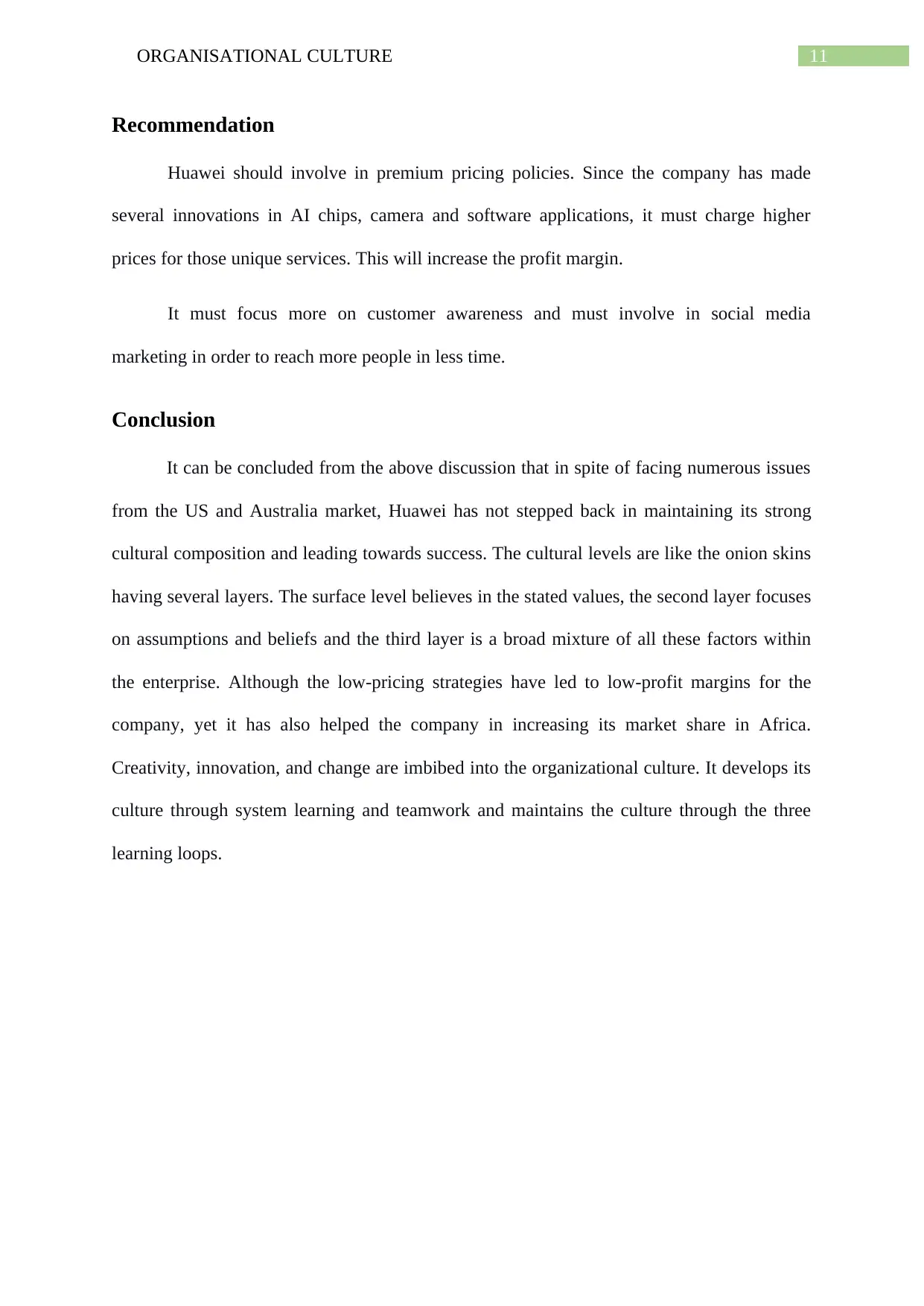
11ORGANISATIONAL CULTURE
Recommendation
Huawei should involve in premium pricing policies. Since the company has made
several innovations in AI chips, camera and software applications, it must charge higher
prices for those unique services. This will increase the profit margin.
It must focus more on customer awareness and must involve in social media
marketing in order to reach more people in less time.
Conclusion
It can be concluded from the above discussion that in spite of facing numerous issues
from the US and Australia market, Huawei has not stepped back in maintaining its strong
cultural composition and leading towards success. The cultural levels are like the onion skins
having several layers. The surface level believes in the stated values, the second layer focuses
on assumptions and beliefs and the third layer is a broad mixture of all these factors within
the enterprise. Although the low-pricing strategies have led to low-profit margins for the
company, yet it has also helped the company in increasing its market share in Africa.
Creativity, innovation, and change are imbibed into the organizational culture. It develops its
culture through system learning and teamwork and maintains the culture through the three
learning loops.
Recommendation
Huawei should involve in premium pricing policies. Since the company has made
several innovations in AI chips, camera and software applications, it must charge higher
prices for those unique services. This will increase the profit margin.
It must focus more on customer awareness and must involve in social media
marketing in order to reach more people in less time.
Conclusion
It can be concluded from the above discussion that in spite of facing numerous issues
from the US and Australia market, Huawei has not stepped back in maintaining its strong
cultural composition and leading towards success. The cultural levels are like the onion skins
having several layers. The surface level believes in the stated values, the second layer focuses
on assumptions and beliefs and the third layer is a broad mixture of all these factors within
the enterprise. Although the low-pricing strategies have led to low-profit margins for the
company, yet it has also helped the company in increasing its market share in Africa.
Creativity, innovation, and change are imbibed into the organizational culture. It develops its
culture through system learning and teamwork and maintains the culture through the three
learning loops.
⊘ This is a preview!⊘
Do you want full access?
Subscribe today to unlock all pages.

Trusted by 1+ million students worldwide
1 out of 14
Related Documents
Your All-in-One AI-Powered Toolkit for Academic Success.
+13062052269
info@desklib.com
Available 24*7 on WhatsApp / Email
![[object Object]](/_next/static/media/star-bottom.7253800d.svg)
Unlock your academic potential
Copyright © 2020–2025 A2Z Services. All Rights Reserved. Developed and managed by ZUCOL.




